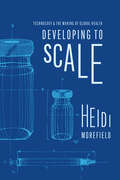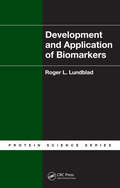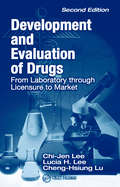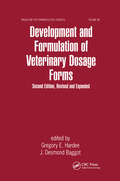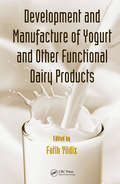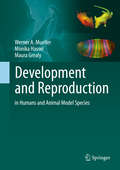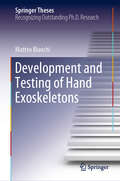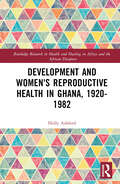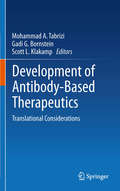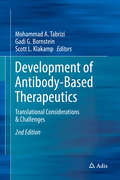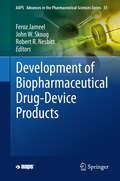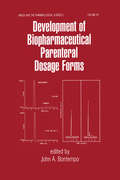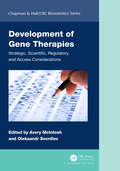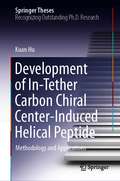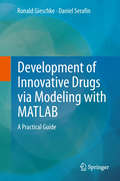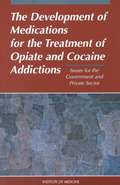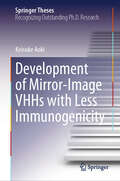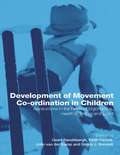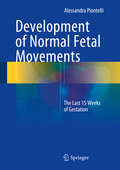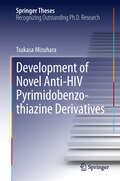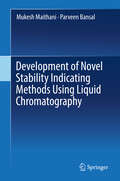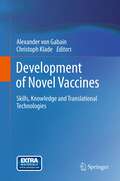- Table View
- List View
Developing the Information Infrastructure for Medicare Beneficiaries: Summary of a Workshop
by Valerie Tate Jopeck Marion Ein LewinThe National Academies Press (NAP)--publisher for the National Academies--publishes more than 200 books a year offering the most authoritative views, definitive information, and groundbreaking recommendations on a wide range of topics in science, engineering, and health. Our books are unique in that they are authored by the nation's leading experts in every scientific field.
Developing to Scale: Technology and the Making of Global Health
by Heidi MorefieldThe first critical book on “appropriate technology,” Developing to Scale shows how global health came to be understood as a problem to be solved with the right technical interventions. In 1973, economist E. F. Schumacher published Small Is Beautiful, which introduced a mainstream audience to his theory of “appropriate technology”: the belief that international development projects in the Global South were most sustainable when they were small-scale, decentralized, and balanced between the traditional and the modern. His theory gained widespread appeal, as cuts to the foreign aid budget, the national interests of nations seeking greater independence, postcolonial activism, and the rise of the United States’ tech sector drove stakeholders across public and private institutions toward cheaper tools. In the ensuing decades, US foreign assistance shifted away from massive modernization projects, such as water treatment facilities, toward point-of-use technologies like village water pumps and oral rehydration salts. This transition toward the small scale had massive implications for the practice of global health. Developing to Scale tells the history of appropriate technology in international health and development, relating the people, organizations, and events that shaped this consequential idea. Heidi Morefield examines how certain technologies have been defined as more or less “appropriate” for the Global South based on assumptions about gender, race, culture, and environment. Her study shows appropriate technology to be malleable, as different constituencies interpreted its ideas according to their own needs. She reveals how policymakers wielded this tool to both constrain aid to a scale that did not threaten Western interests and to scale the practice of global health through the development and distribution of technical interventions.
Development and Application of Biomarkers (Protein Science)
by Roger L. LundbladFirst introduced to biomedical research in 1980, the term biomarker has taken on a life of its own in recent years and has come to mean a number of things. A comprehensive assessment of biomarkers, this book covers the history and current status of the application of biomarkers in diagnostics and prognostics. It explores the technology used for the study of biomarkers, and the validation of biomarkers including a comparison of the various technologies used to identify and measure biomarkers. The editors emphasize the technology underlying biomarkers and the translation of basic science to clinical laboratory technology, including the commercial development of biomarkers. The book also covers proteomics and proteomic technologies and their applications in the identification of biomarkers.
Development and Evaluation of Drugs: From Laboratory through Licensure to Market
by Cheng-Hsiung Lu Lucia H. Lee Chi Jen LeeSince its initial publication in 1993, Development and Evaluation of Drugs from Laboratory through Licensure to Market has been used as a textbook and reference for scientists in biomedical research, industry, and regulatory agencies. Updated and expanded, this second edition examines recent advances in scientific and regulatory approaches as well
Development and Formulation of Veterinary Dosage Forms
by Gregory E. Hardee; J. Desmond BaggotAlthough the United States (U.S.) and the more developed nations of the remainder of the world are blessed with a variety of pharmaceuticals, feed additives, and biological products to treat, prevent, and control animal diseases, there is a healthy desire among persons involved in animal health issues to increase our animal medicine chest. The interest stems from the desire to efficiently produce food that is safe and plentiful and from the desire to have more and better government-approved products available for the prevention and treatment of diseases of dogs, cats, and horses and for an increasing variety of minor animal species. For the animal health industry, increased drug availability means broader markets, increased revenues, and an opportunity to better serve their customers. For the veterinarian, more animal health products means that he or she is better able to treat the usual and the unusual conditions, and to prevent animal disease and suffering. No doubt, we are all winners when new technology and industrial and regulatory initiatives hasten the availability of safe and effective animal health products.
Development and Implementation of Health Technology Assessment: Turning Knowledge into Action (Contributions to Management Science)
by Valentina BerettaThis book analyses the factors that influence the development and implementation of Health Technology Assessment (HTA) from multiple perspectives. It investigates the development of HTA activities in decentralized countries with a specific focus on the analysis of healthcare professionals’ perceptions. Although these perceptions are highly relevant in terms of implementing HTA processes, especially at the local level, they are rarely captured, and require further investigation, which this book provides. In particular, HTA has been introduced as a support tool for reviewing and assessing the introduction and dissemination of healthcare technologies. The book discusses how individual and organisational factors affect knowledge production and translation, and their relevance in the context of HTA. Furthermore, it explores how HTA could be more successfully implemented in decentralized healthcare systems.
Development and Manufacture of Yogurt and Other Functional Dairy Products (500 Tips)
by Fatih YildizWhile the science of yogurt is nearly as old as the origin of mankind, there have been rapid changes in yogurt development since the turn of the 19th century, fueled by continuing developments in biological sciences. Development and Manufacture of Yogurt and Other Functional Dairy Products presents a comprehensive review of all aspects of yogurt an
Development and Reproduction in Humans and Animal Model Species
by Monika Hassel Werner A. Mueller Maura GrealyThis book describes human development including sexual reproduction and stem cell research with the development of model organisms that are accessible to genetic and experimental analysis in readily understandable texts and 315 multi-colored graphics. The introductory account of model organisms selected from the entire animal kingdom presents general principles, which are then outlined in subsequent chapters devoted to, for example, sexual development; genes controlling development and their contemporary molecular-analysis methods; production of clones and transgenic animals; development of the nervous and circulatory systems; regenerative medicine and ageing. Finally the evolution of developmental toolkits and novelties is discussed including the genetic basis of the enlargement of the human forebrain. Separate boxes are devoted to controversial questions such as the benefits and problems of prenatal diagnostics or the construction of ancient body plans.
Development and Testing of Hand Exoskeletons (Springer Theses)
by Matteo BianchiThis book describes the development of portable, wearable, and highly customizable hand exoskeletons to aid patients suffering from hand disabilities. It presents an original approach for the design of human hand motion assistance devices that relies on (i) an optimization-based kinematic scaling procedure, which guarantees a significant adaptability to the user’s hands motion, and (ii) a topology optimization-based design methodology, which allowed the design of a lightweight, comfortable device with a high level of performance. The book covers the whole process of hand exoskeleton development, from establishing a new design strategy, to the construction and testing of hand exoskeleton prototypes, using additive manufacturing techniques. As such, it offers timely information to both researchers and engineers developing human motion assistance systems, especially wearable ones.
Development and Women's Reproductive Health in Ghana, 1920-1982 (Routledge Research in Health and Healing in Africa and the African Diaspora)
by Holly AshfordThis book investigates the history of women's reproductive health in Ghana, arguing that between the 1920s and 1980s, it was largely driven by discourses of development and population control, rather than a concern for women’s health or rights. Between the 1920s and 1980s, the choices that Ghanaian women made regarding their reproductive health were defined by development policy and practice. Spanning the colonial and immediate postcolonial periods, this book demonstrates that whilst the substance of development discourse shifted over time, principles of development continued to be used to impact and legitimise reproductive health policy and practices well after independence. The book explores Ghana’s pluralist health system, the introduction of maternal and child welfare, the dominance of the Red Cross in Ghana’s maternal and child health landscape, nationalist pronatalism and global population activism. In order to understand how global iterations of development and health policy impacted on ordinary lives in Ghana, the author uses evidence from multiple ‘levels’, including private papers, national archives, and records of international and transnational organisations. Providing balanced archival perspectives, the book includes extensive oral history interviews carried out with both rural Ghanaian women and traditional birth attendants, as well as with midwives, doctors and family planning fieldworkers. This book will have an important impact on a number of historical fields including Ghanaian history, global health history, global histories of population and family planning and histories of development. It will be of interest to researchers and students in the history of public health, development, Africa, Ghana and gender.
Development of Antibody-Based Therapeutics
by Gadi G. Bornstein Scott L. Klakamp Mohammad A. TabriziTranslational strategies for development of antibody-based therapeutics should allow understanding of the relationship between the 'unit dose' and 'unit effect' with respect to both beneficial and deleterious effects from early stages of development. The flow of information from later to earlier stages of development should provide opportunities to facilitate selection of more effective novel and next-generation drug candidates. Selection and evaluation of relevant biomarkers in early preclinical development in "relevant" animal models should allow for identifying potential risks to humans and establishing safe First-In-Human (FIH) dosing strategies. Hence, integration of knowledge with respect to target antigen properties such as antigen distribution, expression profile, kinetic properties, target pharmacology, antigen isoforms and pharmacological redundancy in health and disease, as well as antibody design criteria, such as antibody isotype, affinity, PK/PD and safety is a critical necessity for the design of effective translational strategies. Additionally, these factors will further offer critical differentiating characteristics for next-generation antibodies, and novel technologies prove instrumental in generation of biosuperior antibody candidates for market entry. This book will examine many important considerations necessary for the design of effective translational strategies during the development of antibody-based therapeutics.
Development of Antibody-Based Therapeutics: Translational Considerations
by Gadi G. Bornstein Scott L. Klakamp Mohammad A. TabriziWith a key focus on recent developments and advances in the field, this book provides in-depth coverage of topics fundamental to the development of targeted therapeutics. The expansion of targeted modalities in rapidly evolving therapeutic areas, such as immune-oncology, and developments with respect to combination therapies, novel technologies, and the therapeutic application of antibody-drug conjugates, are presented. Additionally, the book builds upon topics discussed in the first edition (2012) where recent innovations warrant elaboration. This, the second edition of Development of Antibody-Based Therapeutics: Translational Considerations, represents a comprehensive evaluation of progress in the field, which sits alongside the first edition to inform, in detail, professional and academic researchers, as well as graduate students.
Development of Biopharmaceutical Drug-Device Products (AAPS Advances in the Pharmaceutical Sciences Series #35)
by Feroz Jameel John W. Skoug Robert R. NesbittThe biotechnology/biopharmaceutical sector has tremendously grown which led to the invention of engineered antibodies such as Antibody Drug Conjugates (ADCs), Bispecific T-cell engager (BITES), Dual Variable Domain (DVD) antibodies, and fusion proteins that are currently being used as therapeutic agents for immunology, oncology and other disease conditions. Regulatory agencies have raised the bar for the development and manufacture of antibody-based products, expecting to see the use of Quality by Design (QbD) elements demonstrating an in-depth understanding of product and process based on sound science. Drug delivery systems have become an increasingly important part of the therapy and most biopharmaceuticals for self-administration are being marketed as combination products. A survey of the market indicates that there is a strong need for a new book that will provide “one stop shopping” for the latest information and knowledge of the scientific and engineering advances made over the last few years in the area of biopharmaceutical product development. The new book entitled Development of Biopharmaceutical Drug Device Products is a reference text for scientists and engineers in the biopharmaceutical industry, academia or regulatory agencies. With insightful chapters from experts in the field, this new book reviews first principles, covers recent technological advancements and provides case studies and regulatory strategies relating to the development and manufacture of antibody-based products. It covers topics such as the importance of early preformulation studies during drug discovery to influence molecular selection for development, formulation strategies for new modalities, and the analytical techniques used to characterize them. It also addresses important considerations for later stage development such as the development of robust formulations and processes, including process engineering and modeling of manufacturing unit operations, the design of analytical comparability studies, and characterization of primary containers (pre-filled syringes and vials).Finally, the latter half of the book reviews key considerations to ensure the development and approval of a patient-centered delivery system design. This involves the evolving regulatory framework with perspectives from both the US and EU industry experts, the role of international standards, design control/risk management, human factors and its importance in the product development and regulatory approval process, as well as review of the risk-based approach to bridging between devices used in clinical trials and the to-be-marketed device. Finally, case studies are provided throughout.The typical readership would have biology and/or engineering degrees and would include researchers, scientific leaders, industry specialists and technology developers working in the biopharmaceutical field.
Development of Biopharmaceutical Parenteral Dosage Forms
by John A. BontempoThis up-to-the-minute reference delineates-in a systematic fashion-the appropriate, sequential steps for the formulation of safe, effective, stable, and marketable liquid parenteral biopharmaceutical products-covering fundamentals and essential pathways for each phase as well as its purpose, function, and relation to other stages in the product development process. Written by experts currently involved in state-of-the-art advances in the pharmaceutical drug industry, Development of Biopharmaceutical Parenteral Dosage Formsdetails biopharmaceuticals that are licensed or undergoing clinical development, including genetically engineered cell and engineered vectors in the fermentation process describes purification and characterization techniques for rDNA therapeutics, discussing several types of unit operations for isolation, purification, and characterization considers preformulation and formulation requirements, such as physicochemical properties, drug delivery, stability studies programs, deactivation/denaturation routes, selection of compatible excipients, and regulatory compliance elucidates basics of analytical techniques, methods development, separation methods using chromatographic and electrophoretic techniques, and bioactivity methods covering bioassays and immunoassays for quantifying the stability of biological activity shows how to select the appropriate filter for maximizing compatibility and minimizing adsorption and inactivation, examining topics from basic filtration theories to future trends reviews the selection process for compatible elastomeric closures, analyzing physical, chemical, toxicological properties, protein adsorption on elastomeric surfaces, strategies to reduce/eliminate adsorption, and specialized containers for biotechnological applications and more! Furnished with helpful references, tables, and drawings, this practical guide is indispensable.
Development of Gene Therapies: Strategic, Scientific, Regulatory, and Access Considerations (Chapman & Hall/CRC Biostatistics Series)
by Oleksandr Sverdlov Avery McIntoshCell and gene therapies have become the third major drug modality in pharmaceutical medicine of the 21st century after low molecular weight and antibody drugs. The gene therapy (GTx) field is rapidly advancing, and yet there are still fundamental scientific questions that remain to be answered. Development of GTx products poses unique challenges and opportunities for drug developers. However, there is lack of a systematic exposition of the GTx product development and the pivotal role of the biostatistician in this process. Development of Gene Therapies: Strategic, Scientific, and Regulatory, and Access Considerations attempts to summarize the current state-of-the-art strategic, scientific, statistical, and regulatory aspects of GTx development. Intended to provide an exposition to the GTx new product development through peer-reviewed papers written by subject matter experts in this emerging field, this book will be useful for researchers in gene therapy drug development, biostatisticians, regulators, patient advocates, graduate students, and the finance and business development community . Key Features: A collection of papers covering a wide spectrum of topics in gene therapies (GTx), written by leading subject matter experts. An exposition of the core principles of GTx product development, emerging business models, industry standards, best practices, and regulatory pathways. An exposition of statistical and innovative modeling tools for design and analysis of clinical trials of GTx. Insights into commercial models, access hurdles, and health economics of gene therapies. Case studies of successful GTx approvals from core team members that developed the first two FDA-approved AAV gene therapies: Luxturna and Zolgensma. A discussion of potential benefits and hurdles to be overcome for GTx in coming years from a multi-stakeholder perspective.
Development of Implantable Electronics as Novel Approaches to Obstructive Sleep Apnea (Springer Theses)
by Jungmin SeoThis book addresses novel methods to treat a very popular disease, obstructive sleep apnea, based on a knowledge of an electrical engineering. Two approaches are given in the book using an upper-airway stimulation based on the pathogenesis of an obstructive sleep apnea. Implantable electronics are devised to control the tongue and the soft palate considering that they are the major pharyngeal muscles contributing to the apnea. First, for tongue control, a cuff electrode was designed and fabricated to stimulate the hypoglossal nerve, which innervates to the tongue muscle. Rare-earth magnets were embedded in the cuff for easy and repeatable installation of the electrode. For soft palate control, a palatal implant system was firstly developed to contract the soft palate muscle by applying electrical stimuli. Comprised of an implant, an intra-oral device, and an external controller, the palatal implant system is fully powered and controlled by means of wireless communication. The approaches were demonstrated in both in vitro and in vivo assessments, in collaboration with department of Otorhinolaryngology, Seoul National University Bundang Hospital.
Development of In-Tether Carbon Chiral Center-Induced Helical Peptide: Methodology and Applications (Springer Theses)
by Kuan HuThis book focuses on the development of stapled peptides, a novel molecular modality used to regulate aberrant intracellular protein–protein interactions (PPIs). The author designs and presents a novel helical peptide stabilization methodology by constructing a chiral cross-linker moiety, namely “chiral center induced peptide helicity (CIH)”. The book demonstrates that a precisely positioned carbon chiral center on tether can decisively determine the secondary structure of a peptide, and that the R-configured peptide is helical, while the S-configured peptide is non-helical. Further, it reports that helicity-enhanced R isomer peptides displayed significantly enhanced cell permeability and target binding affinity, as well as tumor inhibition efficiency, in comparison to S isomer peptides. The book will not only advance readers’ understanding of the basic principle of stapled peptides, but also accelerate the clinical transformation of stapled peptide drugs.
Development of Innovative Drugs via Modeling with MATLAB
by Ronald Gieschke Daniel SerafinThe development of innovative drugs is becoming more difficult while relying on empirical approaches. This inspired all major pharmaceutical companies to pursue alternative model-based paradigms. The key question is: How to find innovative compounds and, subsequently, appropriate dosage regimens? Written from the industry perspective and based on many years of experience, this book offers: - Concepts for creation of drug-disease models, introduced and supplemented with extensive MATLAB programs - Guidance for exploration and modification of these programs to enhance the understanding of key principles - Usage of differential equations to pharmacokinetic, pharmacodynamic and (patho-) physiologic problems thereby acknowledging their dynamic nature - A range of topics from single exponential decay to adaptive dosing, from single subject exploration to clinical trial simulation, and from empirical to mechanistic disease modeling. Students with an undergraduate mathematical background or equivalent education, interest in life sciences and skills in a high-level programming language such as MATLAB, are encouraged to engage in model-based pharmaceutical research and development.
Development of Medications for the Treatment of Opiate and Cocaine Addictions: Issues for the Government and Private Sector
by Committee to Study Medication Development Research at the National Institute on Drug AbusePharmacotherapy, as a means of treating drug addiction in combination with other treatment modalities, has received too little attention from the research community, the pharmaceutical industry, public health officials, and the federal government. Medications to combat drug addiction could have an enormous impact on the medical consequences and socioeconomic problems associated with drug abuse, both for drug-dependent individuals and for American society as a whole. This book examines the current environment for and obstacles to the development of anti-addiction medications, specifically those for treating opiate and cocaine addictions, and proposes incentives for the pharmaceutical industry that would help overcome those obstacles and accelerate the development of anti-addiction medications.
Development of Mirror-Image VHHs with Less Immunogenicity (Springer Theses)
by Keisuke AokiThis book outlines the chemical synthesis of therapeutic targets and a screening process for unexplored mirror-image single-domain antibodies (D-VHH). This book first describes the chemical synthesis of model VHH and the characteristics of both enantiomeric VHHs, including binding activity, biodistribution and immunogenicity. Immunogenicity testing in mice demonstrated that administration of conventional L-VHH induced the generation of anti-drug antibodies while D-VHH-binding antibodies were not observed in D-VHH-immunized mice. Second, it is explained that the T7-phage-based mirror-image screening system was developed to identify D-VHH antibody fragments capable of binding to vascular endothelial growth factors. Additionally, this book details the chemical synthesis of full-length hepatitis B virus core protein and interleukin-6 for the application of exploring D-VHHs and other mirror-image molecules. Demonstrating that it is possible to develop a D-VHH that preferentially binds the native target protein and exhibits reduced immunogenicity, this book is useful for anyone interested in developing alternative biotherapeutics with reduced immunogenicity by combining chemical and biological approaches.
Development of Movement Coordination in Children: Applications in the Field of Ergonomics, Health Sciences and Sport
by Keith Davids Geert Savelsbergh John van der Kamp Simon J. BennettCo-ordination of movement plays a key role in human development and is an important area in sport and health sciences. This book looks in detail at how children develop basic skills, such as walking and reaching for objects, and more complex skills such as throwing and catching a ball accurately or riding a bicycle. Development of Movement Co-ordination in Children is informed by five major theoretical perspectives and are explained in an introductory chapter: * neural maturation* information processing* direct perception* dynamic systems* constraint theory. The international contributions are brought together under the headings of ergonomics, health sciences and sport. Focusing on practical applications, individual chapters cover many different aspects of movement behaviour and development, ranging from children's over-estimation of their physical abilities and the links to injury proneness, to the co-ordination of kicking techniques. Both normal and abnormal development is considered. This text will be of considerable interest to students, teachers and professionals in the fields of sport science, kinesiology, physical education, ergonomics and developmental psychology.
Development of Normal Fetal Movements
by Alessandra PiontelliIn the later stages of gestation, fetal functions undergo increasing change and development, preparing the fetus for the transition to its postnatal environment. Rapid maturation is witnessed in breathing, swallowing, sensory functions, sleep, and many other processes, with corresponding behavioral changes. By 35 to 40 weeks of gestation, fetuses are capable of living ex utero without support, but it is increasingly appreciated that even infants born at between 35 and 36 weeks can suffer long-term consequences. This book, which complements the author's previous volume on development of normal fetal movements during the first 25 weeks of gestation, discusses in detail the full range of behavioral phenomena observed during the final 15 weeks of gestation, with careful analysis of their mutual relationships. A key feature is the outstanding photographic material, difficult to obtain at this late stage, and the instructive graphs that are also included. The information provided will alert clinicians to deviations from the norm and to physiologic phenomena that can turn pathologic in infants born prematurely.
Development of Novel Anti-HIV Pyrimidobenzothiazine Derivatives
by Tsukasa MizuharaThe author successfully developed novel anti-HIV PD 404182 derivatives that exhibited submicromolar inhibitory activity against both HIV-1 and HIV-2. His thesis is in three parts. The first part expounds efficient methods for the synthesis of tricyclic heterocycles related to PD 404182 based on the sp2-carbon−heteroatom bond formations. Starting from arene or haloarene, C-O, C-N, or C-S bonds were formed by simply changing the reactants. These synthetic methods provide powerful approaches for the divergent preparation of pyrimido-benzoxazine, -quinazoline, or -benzothiazine derivatives. The second part explains SAR studies of PD 404182 for the development of anti-HIV agents. Through optimization studies of the central 1,3-thiazin-2-imine core, the benzene and cyclic amidine ring parts, 3-fold more potent inhibitors were obtained compared with the lead compound. The author also reveals by a time-of-drug-addition experiment that PD 404182 derivatives impaired HIV replication at the binding or fusion stage. The third part of the thesis elucidates the development of photoaffinity probes for the target identification of PD 404182. By the photolabeling experiment of HIV-1-infected H9 cells using these probes, the author detected proteins specifically bound to PD 404182. These new anti-HIV agents may be promising agents for anti-HIV therapy because their mechanisms of action differ from those of the currently approved anti-HIV agents.
Development of Novel Stability Indicating Methods Using Liquid Chromatography
by Mukesh Maithani Parveen BansalReversed-phase high-performance liquid chromatography (RP-HPLC) has become the most widely used method for pharmaceutical analysis, as it ensures accuracy, specificity and reproducibility for the quantification of drugs, while avoiding interference from any of the excipients that are normally present in pharmaceutical dosage forms. This book presents a simple methodology for developing stability-indicating methods and offers a ‘how-to guide’ to creating novel stability-indicating methods using liquid chromatography. It provides the detailed information needed to devise a stability-indicating method for drug substances and drug products that comply with international regulatory guidelines. As such, it is a must-read for anyone engaged in analytical and bioanalytical chemistry: professionals at reference, test, and control laboratories; students and academics at research laboratories, and scientists working for chemical, pharmaceutical, and biotechnology companies.
Development of Novel Vaccines
by Alexander Von Gabain Christoph Klade"Development of novel vaccines" gives an overview of the tasks in basic research leading to the final product - the vaccine and its applications, belonging to the most complex biologics in the pharmaceutical field. Distinct from most textbooks in the vaccine arena, the current issue focuses on the translational aspect, namely, how research results can be transformed into life-saving medical interventions. Each chapter of the book deals with one important paradigm for the development of novel vaccines, along the value chain towards the final vaccine, and furthermore, with the inevitable tools required for this process. Contributions are prepared by teams of scientists, all of whom are experts in the field, most of them anchored in biomedical organizations devoted to translational culture, thereby lighting the certain topics from different views. This volume is a must read for researchers engaged in vaccine development and who really want to see their research results to become a product.

